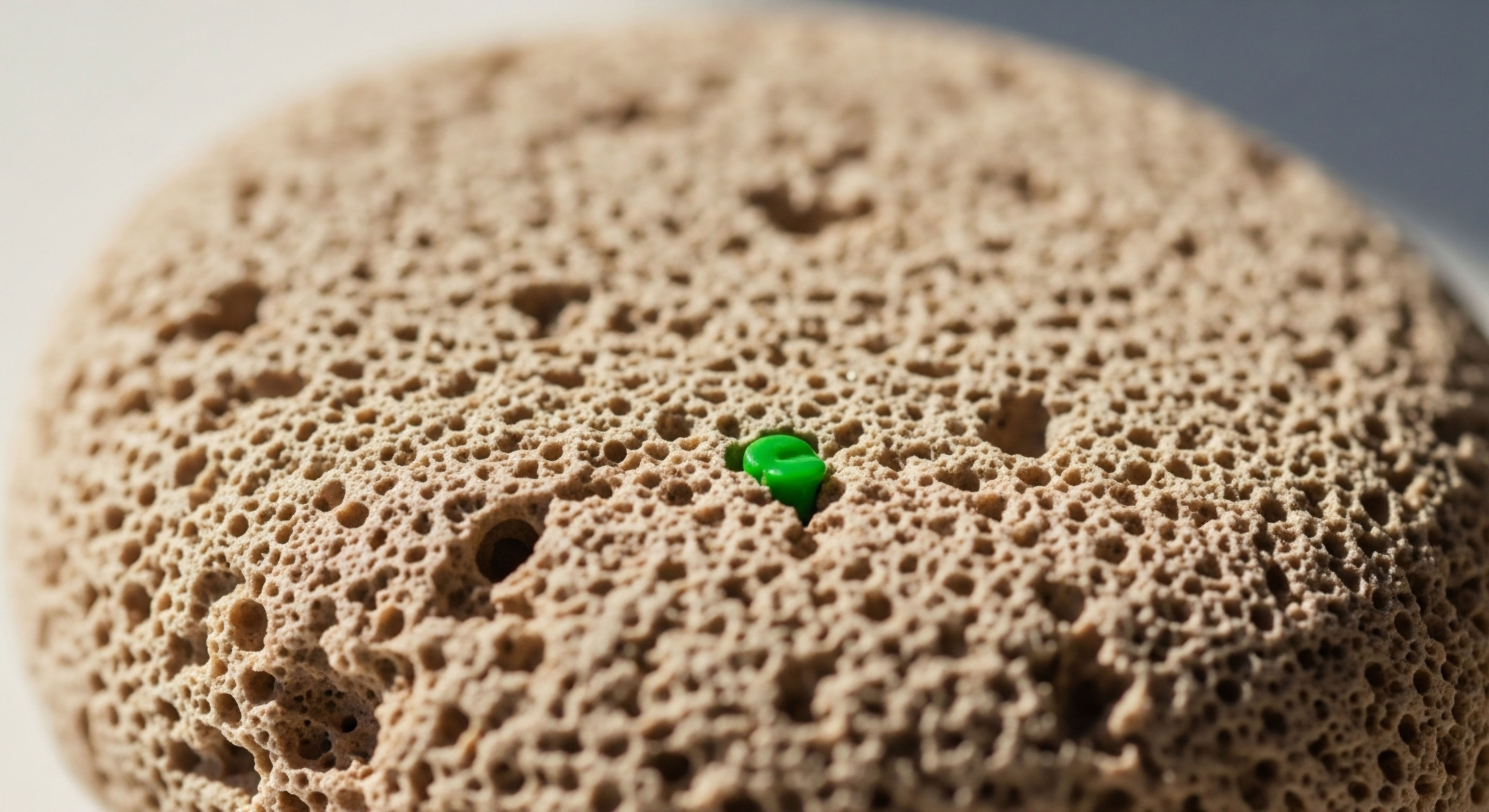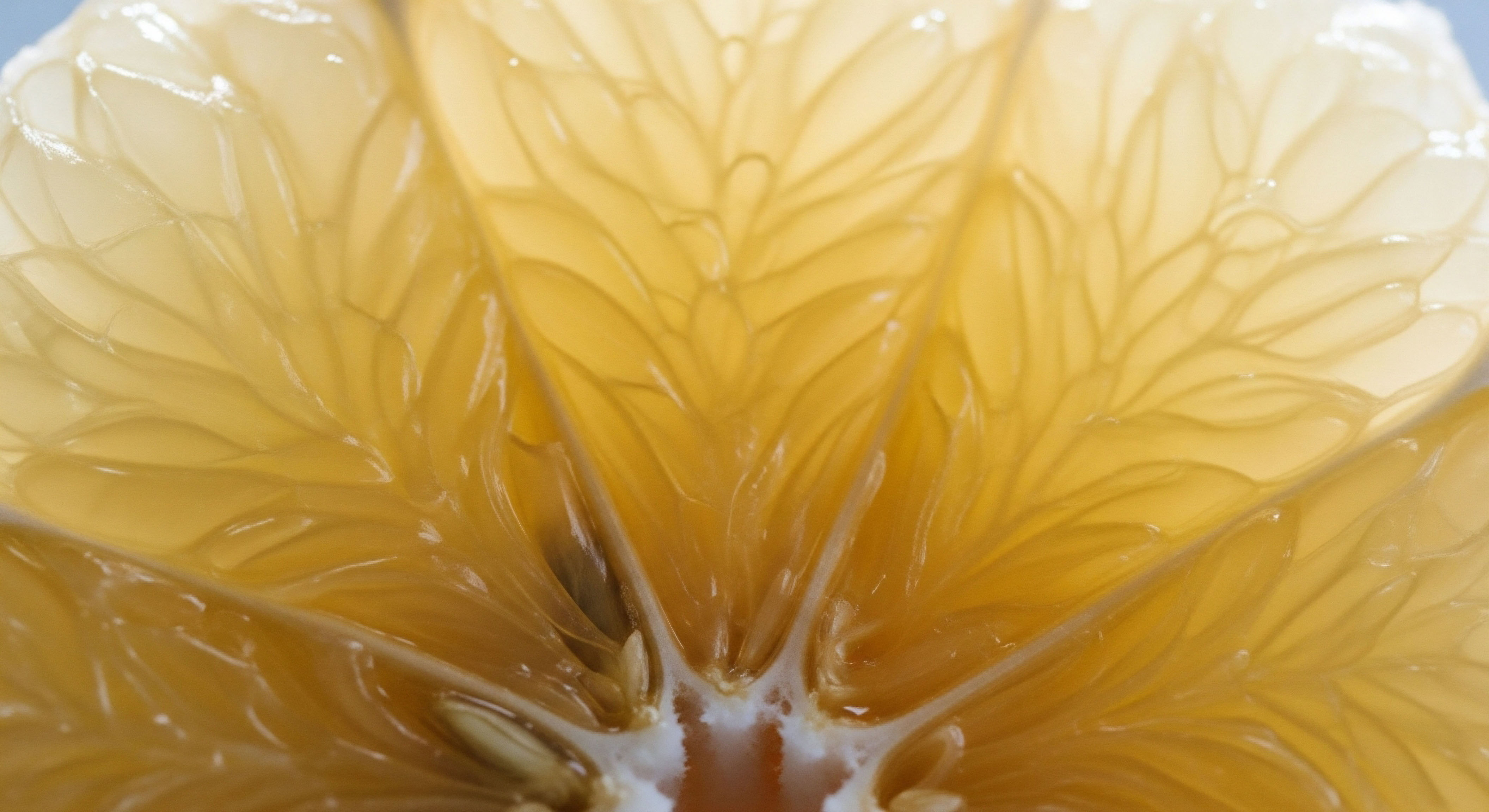

Fundamentals
Experiencing discomfort after an injection can feel disorienting, a sensation that often prompts questions about its normalcy. Many individuals undergoing therapeutic protocols, particularly those involving hormonal recalibration, encounter this localized soreness. This physical manifestation, often termed post-injection pain, is a common experience, yet its presence can understandably cause concern. Understanding the underlying biological responses that contribute to this sensation can transform apprehension into informed awareness, allowing you to approach your wellness journey with greater clarity.
Your body possesses an intricate network of systems, each communicating through a complex array of signals. The endocrine system, a master orchestrator of these internal messages, relies on hormones to regulate nearly every physiological process. When we introduce therapeutic agents, such as those used in hormonal optimization Meaning ∞ Hormonal Optimization is a clinical strategy for achieving physiological balance and optimal function within an individual’s endocrine system, extending beyond mere reference range normalcy. protocols, we are engaging with this sophisticated internal communication system. The body’s immediate reaction to an injection, whether it is a slight ache or a more pronounced tenderness, is a testament to its vigilant protective mechanisms.
Post-injection pain is a common physical response during therapeutic protocols, reflecting the body’s natural protective mechanisms.

Understanding the Body’s Initial Response
When a needle penetrates the skin and muscle tissue, a cascade of events begins at the cellular level. This mechanical disruption triggers a localized inflammatory response, a natural and essential part of the body’s healing process. Tiny blood vessels may be affected, and muscle fibers can experience minor trauma. This initial insult prompts the release of various chemical mediators, signaling the immune system to initiate repair.
The sensation of pain arises from the activation of specialized nerve endings, known as nociceptors, which detect tissue damage or irritation. These signals travel along neural pathways to the brain, where they are interpreted as discomfort. The intensity of this sensation can vary widely among individuals, influenced by factors such as injection technique, the specific substance administered, and individual pain thresholds. Recognizing this as a physiological process, rather than an anomaly, helps in managing expectations and reducing anxiety.

Hormonal Health and Systemic Well-Being
The journey toward hormonal balance Meaning ∞ Hormonal balance describes the physiological state where endocrine glands produce and release hormones in optimal concentrations and ratios. involves a deep appreciation for the body’s interconnectedness. Hormones do not operate in isolation; their actions ripple throughout the entire physiological landscape. For instance, the hypothalamic-pituitary-gonadal (HPG) axis, a central regulatory pathway, governs the production of sex hormones like testosterone and estrogen. Disruptions within this axis can manifest in a wide array of symptoms, from altered energy levels and mood fluctuations to changes in body composition.
Personalized wellness Meaning ∞ Personalized Wellness represents a clinical approach that tailors health interventions to an individual’s unique biological, genetic, lifestyle, and environmental factors. protocols, including those involving hormonal optimization, aim to restore equilibrium within these vital systems. Addressing symptoms such as fatigue, diminished vitality, or metabolic shifts often requires a precise recalibration of endocrine function. The discomfort associated with injections, while localized, occurs within this broader context of systemic adjustment. Viewing it as a transient aspect of a comprehensive strategy for health restoration can alter one’s perception of the experience.

The Role of Inflammation in Recovery
Inflammation, often perceived negatively, serves a critical purpose in tissue repair. Following an injection, localized inflammation brings immune cells and growth factors to the site, clearing cellular debris and initiating the rebuilding process. This controlled inflammatory state is a necessary precursor to healing. The discomfort experienced is often a direct consequence of this beneficial biological activity.
Understanding that a certain degree of localized inflammation is a sign of the body actively responding and repairing can provide reassurance. The goal is not to eliminate all inflammatory responses, but to manage their intensity and duration, ensuring they remain within a beneficial range for recovery. Strategies to mitigate post-injection discomfort often target the modulation of this inflammatory cascade.


Intermediate
Navigating the landscape of personalized wellness protocols html Meaning ∞ Personalized Wellness Protocols represent bespoke health strategies developed for an individual, accounting for their unique physiological profile, genetic predispositions, lifestyle factors, and specific health objectives. requires a clear understanding of the therapeutic agents employed and their specific administration methods. Post-injection pain, while a common experience, can often be minimized through meticulous technique and an appreciation for the biochemical properties of the substances being introduced. This section explores the clinical protocols relevant to managing this discomfort, detailing the ‘how’ and ‘why’ of various strategies.
Meticulous technique and understanding biochemical properties can minimize post-injection pain during personalized wellness protocols.

Targeted Hormonal Optimization Protocols
Hormonal optimization protocols html Meaning ∞ Hormonal Optimization Protocols are systematic clinical strategies designed to restore or maintain optimal endocrine balance. are designed with precision, addressing the distinct physiological needs of individuals. Whether supporting male hormone balance or recalibrating female endocrine function, the choice of medication, dosage, and administration route plays a significant role in both therapeutic efficacy and patient comfort.

Testosterone Replacement Therapy for Men
For men experiencing symptoms of diminished testosterone, a common protocol involves weekly intramuscular injections Meaning ∞ An intramuscular injection represents a medical procedure where a substance, typically a medication, is directly administered into the deep muscle tissue, facilitating its absorption into the systemic circulation. of Testosterone Cypionate (200mg/ml). This method delivers the hormone directly into muscle tissue, allowing for gradual absorption into the bloodstream. The volume of fluid injected and the viscosity of the oil carrier can influence the degree of localized discomfort.
To support natural testosterone production and fertility, Gonadorelin is often included, administered via subcutaneous injections Meaning ∞ Subcutaneous injections involve administering medication into the adipose tissue layer located beneath the dermis and epidermis, superior to the muscle fascia. twice weekly. This peptide stimulates the pituitary gland, maintaining the integrity of the HPG axis. Additionally, Anastrozole, an oral tablet taken twice weekly, helps manage estrogen conversion, reducing potential side effects. Some protocols may also incorporate Enclomiphene to further support luteinizing hormone (LH) and follicle-stimulating hormone ( (FSH) levels, contributing to a more balanced endocrine environment.
Minimizing discomfort with these injections involves several considerations:
- Injection Site Selection ∞ Rotating injection sites (e.g. gluteal muscles, vastus lateralis) helps prevent localized tissue fatigue and scar tissue buildup.
- Needle Gauge and Length ∞ Using an appropriate needle size for intramuscular injections can reduce trauma.
- Injection Speed ∞ Administering the solution slowly allows the muscle tissue to accommodate the fluid more gradually.
- Temperature of Solution ∞ Allowing the medication to reach room temperature before injection can reduce viscosity and discomfort.

Testosterone Replacement Therapy for Women
Women experiencing hormonal shifts, such as those in peri-menopause or post-menopause, may benefit from specific testosterone protocols. Typically, Testosterone Cypionate is administered weekly via subcutaneous injection, often in smaller doses (e.g. 10–20 units or 0.1–0.2ml). This subcutaneous route involves injecting into the fatty tissue just beneath the skin, which can sometimes be less irritating than intramuscular delivery for smaller volumes.
Progesterone is frequently prescribed based on menopausal status, playing a crucial role in female hormonal balance. Another option for sustained testosterone delivery is Pellet Therapy, where long-acting testosterone pellets are inserted subcutaneously. When appropriate, Anastrozole may also be used in conjunction with pellet therapy to manage estrogen levels.
For subcutaneous injections, the following can aid in reducing discomfort:
- Pinch Technique ∞ Gently pinching the skin creates a small mound of fatty tissue, making the injection smoother.
- Shallow Angle ∞ Injecting at a 45-degree angle for thinner individuals or 90 degrees for those with more subcutaneous fat.
- Post-Injection Pressure ∞ Applying gentle pressure to the site immediately after needle withdrawal can help disperse the medication and reduce bruising.

Peptide Therapies and Administration
Peptide therapies represent another avenue in personalized wellness, targeting specific physiological functions such as anti-aging, muscle gain, or tissue repair. These agents, being smaller protein chains, often require subcutaneous administration.
Common peptides include Sermorelin, Ipamorelin / CJC-1295, Tesamorelin, and Hexarelin, often used for growth hormone optimization. MK-677 is an oral secretagogue. For sexual health, PT-141 is utilized, while Pentadeca Arginate (PDA) supports tissue repair Meaning ∞ Tissue repair refers to the physiological process by which damaged or injured tissues in the body restore their structural integrity and functional capacity. and modulates inflammation.
The typical administration for these peptides involves small-gauge insulin syringes for subcutaneous injection. The principles for minimizing discomfort are similar to those for subcutaneous testosterone, emphasizing careful site selection and slow injection.
| Injection Type | Primary Sites | Considerations for Comfort |
|---|---|---|
| Intramuscular (IM) | Deltoid, Gluteal, Vastus Lateralis | Muscle relaxation, appropriate needle length, slow administration. |
| Subcutaneous (SC) | Abdomen, Thigh, Upper Arm | Pinching skin, shallow angle, room temperature medication. |

Post-TRT or Fertility-Stimulating Protocols for Men
For men discontinuing testosterone replacement or seeking to restore fertility, specific protocols are implemented to reactivate endogenous hormone production. These often include Gonadorelin, Tamoxifen, and Clomid. Anastrozole may be included as an optional component to manage estrogen levels during this transition.
The administration routes for these agents vary, with Gonadorelin typically subcutaneous and Tamoxifen and Clomid being oral medications. The focus here shifts from managing injection site discomfort to supporting the body’s intrinsic hormonal pathways.
The discomfort experienced from injections is a transient phenomenon, often a minor aspect of a larger, beneficial process. By understanding the mechanisms behind post-injection pain and applying careful administration techniques, individuals can significantly reduce its impact, allowing for a more comfortable and consistent adherence to their personalized wellness strategies.
Academic
The experience of post-injection pain, while seemingly localized, represents a complex interplay of physiological responses deeply connected to the broader endocrine and immune systems. A deeper examination reveals that the body’s reaction to exogenous substance introduction is not merely a mechanical event but a finely tuned biological cascade involving cellular signaling, inflammatory mediators, and neural pathways. This section delves into the endocrinological underpinnings and systemic implications of injection-related discomfort, analyzing it from a systems-biology perspective.
Post-injection pain reflects a complex interplay of endocrine and immune responses, extending beyond a simple mechanical event.

The Neuro-Endocrine-Immune Axis and Localized Response
The initial mechanical trauma of an injection triggers immediate cellular damage and the release of intracellular contents, including adenosine triphosphate (ATP) and potassium ions. These molecules act as danger-associated molecular patterns (DAMPs), recognized by resident immune cells such as mast cells and macrophages. These cells, in turn, release a variety of pro-inflammatory cytokines and chemokines, including interleukin-1 beta (IL-1β), tumor necrosis factor-alpha (TNF-α), and histamine. These mediators increase vascular permeability, leading to localized edema and redness, characteristic signs of inflammation.
Simultaneously, the mechanical distortion and chemical irritation activate peripheral nociceptors, specialized sensory neurons. These neurons transmit pain signals via Aδ and C fibers to the dorsal horn of the spinal cord, then ascending pathways to the brain. The intensity and duration of this pain are modulated by the local concentration of inflammatory mediators, which can sensitize these nociceptors, a phenomenon known as peripheral sensitization.
The endocrine system plays a subtle yet significant role in modulating this local inflammatory response. Hormones like cortisol, released from the adrenal cortex under stress, possess potent anti-inflammatory properties. While acute stress from an injection might transiently elevate cortisol, chronic systemic hormonal imbalances can alter the body’s overall inflammatory set point, potentially influencing the magnitude and resolution of localized pain. For instance, individuals with suboptimal thyroid function or adrenal dysregulation might exhibit altered inflammatory responses.

Pharmacokinetics of Injected Hormones and Peptides
The physical properties of the injected substance significantly influence the local tissue reaction. Testosterone Cypionate, for example, is an esterified form of testosterone dissolved in an oil vehicle (e.g. cottonseed oil, sesame oil). The oil’s viscosity and the ester chain length dictate the rate of release from the injection depot.
A more viscous solution or a larger volume can create greater tissue distension, contributing to mechanical irritation and localized pressure. The slow hydrolysis of the ester bond releases free testosterone, maintaining stable serum levels over several days.
Peptides, such as Sermorelin or Ipamorelin, are typically administered subcutaneously in aqueous solutions. While less viscous than oil-based preparations, the local tissue reaction Female testosterone therapy, when physiologically dosed, appears to offer breast protection and does not increase mammographic density. can still occur due to the presence of excipients, pH differences, or the direct pharmacological action of the peptide itself on local receptors. For instance, some peptides might directly influence local mast cell degranulation or alter microvascular tone, contributing to transient discomfort.
Consider the impact of injection volume and concentration:
- Higher Volume ∞ Greater mechanical distension of tissue, potentially leading to more discomfort.
- Higher Concentration ∞ While reducing volume, a highly concentrated solution might cause local osmotic shifts or chemical irritation.
- Vehicle Type ∞ Different oil carriers or aqueous solutions can elicit varying degrees of local tissue reaction and absorption rates.

Systemic Influences on Localized Pain Perception
The perception of pain is not solely a local phenomenon; it is profoundly influenced by central nervous system processing and systemic physiological states. The Hypothalamic-Pituitary-Adrenal (HPA) axis, the body’s central stress response system, interacts intimately with the immune system. Chronic stress or dysregulation of the HPA axis can lead to altered pain thresholds and heightened sensitivity to noxious stimuli. This means an individual under chronic physiological stress might perceive post-injection discomfort more intensely than someone with a well-regulated stress response.
Moreover, metabolic health plays a role. Conditions such as insulin resistance or chronic low-grade systemic inflammation, often associated with metabolic dysfunction, can exacerbate local inflammatory responses and delay tissue repair. The body’s ability to efficiently resolve inflammation is crucial for minimizing persistent post-injection pain. Hormonal optimization protocols, by improving metabolic parameters and reducing systemic inflammation, can indirectly contribute to a more favorable local healing environment over time.
| Factor Category | Specific Influences | Biological Mechanism |
|---|---|---|
| Injection Technique | Needle gauge, injection speed, site rotation | Minimizes mechanical trauma, tissue distension, and localized irritation. |
| Substance Properties | Viscosity, pH, excipients, volume | Affects tissue accommodation, chemical irritation, and inflammatory mediator release. |
| Individual Physiology | Pain threshold, HPA axis regulation, metabolic health, immune status | Modulates central pain processing, systemic inflammatory response, and tissue repair kinetics. |
The goal of personalized wellness protocols Meaning ∞ Wellness Protocols denote structured, evidence-informed approaches designed to optimize an individual’s physiological function and overall health status. extends beyond simply administering a therapeutic agent. It encompasses optimizing the entire physiological milieu to support the body’s adaptive responses, including its reaction to injections. By considering the intricate connections between the neuro-endocrine-immune axis, the pharmacokinetics of the administered compounds, and the individual’s systemic health, clinicians can devise strategies that not only deliver therapeutic benefit but also enhance patient comfort and adherence. This holistic perspective transforms the understanding of post-injection pain from a mere side effect into a valuable indicator of the body’s dynamic biological state.
References
- Guyton, A. C. & Hall, J. E. (2020). Textbook of Medical Physiology (14th ed.). Elsevier.
- Boron, W. F. & Boulpaep, E. L. (2017). Medical Physiology (3rd ed.). Elsevier.
- Becker, K. L. (Ed.). (2001). Principles and Practice of Endocrinology and Metabolism (3rd ed.). Lippincott Williams & Wilkins.
- Nieschlag, E. & Behre, H. M. (Eds.). (2012). Testosterone ∞ Action, Deficiency, Substitution (5th ed.). Cambridge University Press.
- Swerdloff, R. S. & Wang, C. (2017). Androgens and the Aging Male. Humana Press.
- Miller, K. K. & Klibanski, A. (2018). Clinical Management of Women with Hypopituitarism. Springer.
- Bhasin, S. & Jasuja, R. (2017). Regulation of Lean Body Mass and Muscle Function by Androgens. Current Opinion in Clinical Nutrition and Metabolic Care, 20(3), 224-230.
- Veldhuis, J. D. & Johnson, M. L. (2018). Physiological Control of Growth Hormone Secretion. Growth Hormone & IGF Research, 40, 1-13.
- Walker, A. K. & Reiner, J. (2019). The Role of Inflammation in Pain. Pain Management, 9(2), 105-115.
- Basbaum, A. I. & Jessell, T. M. (2000). The Perception of Pain. In E. R. Kandel, J. H. Schwartz, & T. M. Jessell (Eds.), Principles of Neural Science (4th ed. pp. 472-491). McGraw-Hill.
Reflection
Considering your own health journey often brings moments of clarity, particularly when confronting physical sensations that prompt inquiry. The knowledge gained about post-injection discomfort, its biological roots, and its connection to your broader endocrine landscape, serves as a foundation. This understanding is not an endpoint; it is a starting point for deeper self-awareness. Your body’s responses are signals, providing valuable information about its current state and its adaptive capacities.
Recognizing that discomfort can be a temporary aspect of a beneficial process allows for a more proactive stance. It prompts a shift from passive acceptance to active participation in your wellness strategy. Each step taken to support your hormonal balance and metabolic function html Meaning ∞ Metabolic function refers to the sum of biochemical processes occurring within an organism to maintain life, encompassing the conversion of food into energy, the synthesis of proteins, lipids, nucleic acids, and the elimination of waste products. contributes to a more resilient physiological system. This personal journey toward vitality is a continuous process of learning, adjusting, and aligning with your body’s intrinsic intelligence.

What Does Hormonal Balance Mean for Daily Living?
Hormonal balance extends beyond laboratory values; it influences your daily energy, mood stability, and overall sense of well-being. When your endocrine system operates harmoniously, you experience greater resilience to stressors and an enhanced capacity for physical and mental performance. This state allows for a more vibrant and functional existence.

How Can Lifestyle Choices Support Endocrine Health?
Lifestyle choices, including nutrition, physical activity, and stress management, profoundly influence endocrine function. These elements work synergistically with personalized protocols to optimize hormonal pathways. Making informed decisions in these areas can amplify the benefits of therapeutic interventions, supporting long-term health and vitality.














